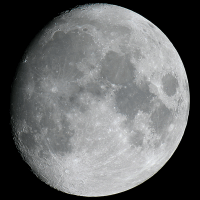Moon
From Gwn
| Earth's Moon | |

| |
| Discovered: | Always known to humanity. |
| Named After: | Colloquial Term |
| Relative Size: | 0.03 Earths |
| Satellites: | None |
The Moon is Earth's only natural satellite. It has no formal name other than "the Moon", although it is occasionally called Luna (Latin: moon) to distinguish it from the generic term "moon" (referring to any of the various natural satellites of other planets). Its symbol is a crescent (☽). The related adjective for the Moon is lunar (from the Latin root).
Contents |
History
The Moon has been the subject of many works of art and literature and the inspiration for countless others. A 5,000 year old rock carving at Knowth, Ireland may represent the Moon, which would be the earliest depiction discovered. In many prehistoric and ancient cultures, the Moon was thought to be a deity or other supernatural phenomenon, and astrological views of the Moon continue to be propagated today.
In 1609, Galileo Galilei drew one of the first telescopic drawings of the Moon in his book Sidereus Nuncius and noted that it was not smooth but had mountains and craters. Later in the 17th century, Giovanni Battista Riccioli and Francesco Maria Grimaldi drew a map of the Moon and gave many craters the names they still have today.
On maps, the dark parts of the Moon's surface were called maria (singular mare) or seas, and the light parts were called terrae or continents. The possibility that the Moon could contain vegetation and be inhabited by selenites was seriously considered by some major astronomers even into the first decades of the 19th century. The contrast between the brighter highlands and darker maria create the patterns seen by different cultures as the Man in the Moon, the rabbit and the buffalo, amongst others.
Exploration
With only 1/6th of the gravity of Earth, the Moon was not an appropriate place for humans to reside. Upon completion of the Space Colonies, construction was started on lunar research facilities and major factories for various uses. The Moon further developed into a popular outerspace tourist destination for people from Earth, and prospered significantly until the suppression by the Alliance. After OZ's dismantling of the Alliance military was complete, the Moon was once again allowed to conduct business as a tourist destination. People took this as a sign peace was returning to space.
Steady Habitation
After the Eve Wars, the Earth established a steady nation. The Lunar Federation oversaw all human and industrial settlements on the moon. The Nation would only last 22 years, before the Earth First Federation invaded and annexed both the moon and her colonies. Conflicts betwen the Earth and colonies would tear the moon apart, causing the celestial body to be divided through countless treaties between the Earth First Federation and La Grange Pointe Council.
The Gemini Foundation siezed control of the Moon on July 14, AC 260. They siezed control of the satellite because of several viens of a rare mineral, which they nicknamed Genesis. Gemini would retain posession of the moon until its defeat, changing how the moon would be settled. Many tunnels and factories sprawled out during Gemini posession. Even after the Gemini Foundation became dissolved, humans would still use many structures built.
The fracturing of the Moon
AC 275
Meaning of the Name
The English word "earth" has cognates in many modern and ancient languages. Examples in modern tongues include aarde in Afrikaans and Dutch, and Erde in German. The root has cognates in extinct languages such as ertha in Old Saxon and ert (meaning "ground") in Middle Irish, derived from the Old English eorðe. All of these words derive from the Proto-Indo-European base *er-.
Words for Earth in other languages include: Terre (French), पृथ्वी pr̥thvī (Sanskrit), Maa (Finnish and Estonian), Pământ (Romanian), Föld (Hungarian), Ziemia (Polish), Zemlja (Russian and Serbian), Zemya Земя (Bulgarian), Tierra (Spanish), Terra (Italian), Diqiu (Mandarin), Deiqao (Cantonese), Jigu (Korean), Bumi (Malay), Chikyuu (Japanese), Jorden (Danish, Norwegian, Swedish), כדור הארץ (Hebrew), Bhoomi (Telugu), Gi, Choma (Greek), Dunia (Swahili), Âlem, Dünya الْمَسْكُونَة (Arabic), Dinê (Kurdish), Ergir երկիր (Armenian), Jehun, Zamin (Persian), and Acun, Yeryüzü, Yerküre (Turkish).
